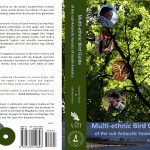 In 1995, Ricardo Rozzi and a group of colleagues working on Chiloe Island first had the idea of creating a bird guide that would take into account diverse forms of knowing these abundant and diverse creatures. Over the past 15 years, numerous photographers, artists, researchers, poets, students and native elders have worked to produce the the Multi-Ethnic Bird Guide to the Sub-Antarctic Forests of South America. In this unique book, Rozzi and collaborators combine science and traditional ecological knowledge about fifty bird species of southern Chile, providing its names in Yahgan, Mapudungun, Spanish, English and scientific nomenclature, an ecological description, full color photographs and distribution maps. According to Dr. Chris Elphick (co-author of the Sibley Guide to Bird Life and Behavior) this publication is “highly original in its approach of combining information on natural history and biodiversity with information on the region’s human culture and linguistic diversity.”
In 1995, Ricardo Rozzi and a group of colleagues working on Chiloe Island first had the idea of creating a bird guide that would take into account diverse forms of knowing these abundant and diverse creatures. Over the past 15 years, numerous photographers, artists, researchers, poets, students and native elders have worked to produce the the Multi-Ethnic Bird Guide to the Sub-Antarctic Forests of South America. In this unique book, Rozzi and collaborators combine science and traditional ecological knowledge about fifty bird species of southern Chile, providing its names in Yahgan, Mapudungun, Spanish, English and scientific nomenclature, an ecological description, full color photographs and distribution maps. According to Dr. Chris Elphick (co-author of the Sibley Guide to Bird Life and Behavior) this publication is “highly original in its approach of combining information on natural history and biodiversity with information on the region’s human culture and linguistic diversity.”
Dr. Christopher Anderson, coordinator of the Sub-Antarctic Biocultural Conservation Program, noted that “this is the first in a series of publications that Dr. Rozzi has preposed and that our program has undertaken to establish and editorial line in biocultural conservation between the University of North Texas and the Universidad de Magallanes. The goal is to create field guides, translations and original scholarship that facilitates communication and dialogue between the humanities and the sciences and between Latin America and English-speaking America.”
To launch this book, the Sub-Antarctic Biocultural Conservation Program hosted an evening celebration of art, poetry, philosophy and science, which was headlined by co-author, poet and uñumche (Mapuche birdman) Lorenzo Aillapán to UNT to offer his poetry in a public presentation and to various classes. Likewise, Paola Vezzani, designer of the new edition and currently Regional Director of Culture for Magallanes, attended the launching ceremony to talk about the link this book expresses between science and the arts. These events also coincided with the one year anniversary of the Sub-Antarctic Biocultural Conservation Program, which allowed as well the inauguration of the program’s new offices in the EESAT Building, an event attended by the university administration, faculty, student and other friends.
For more information or to order this new book visit UNT Press.
